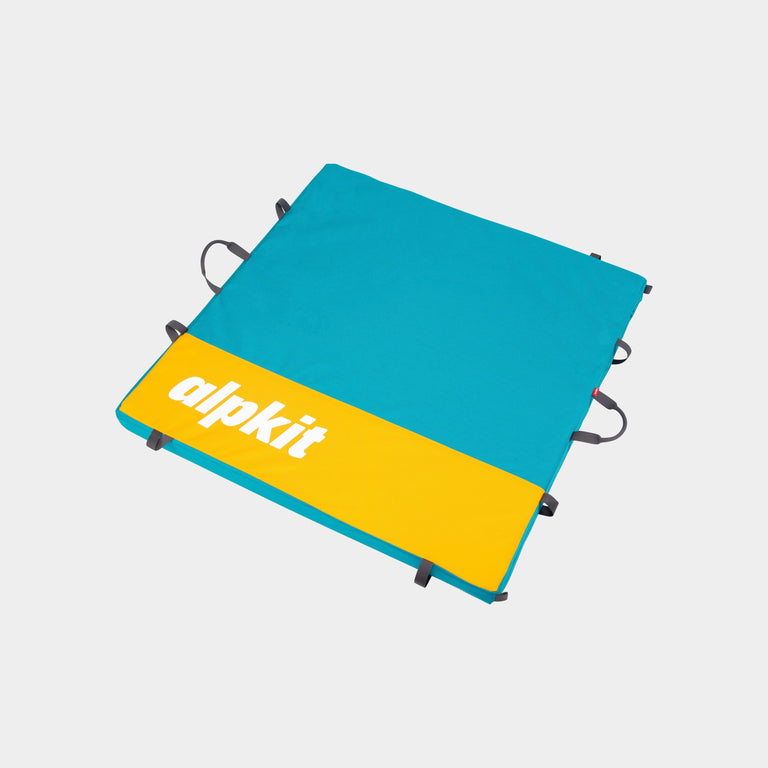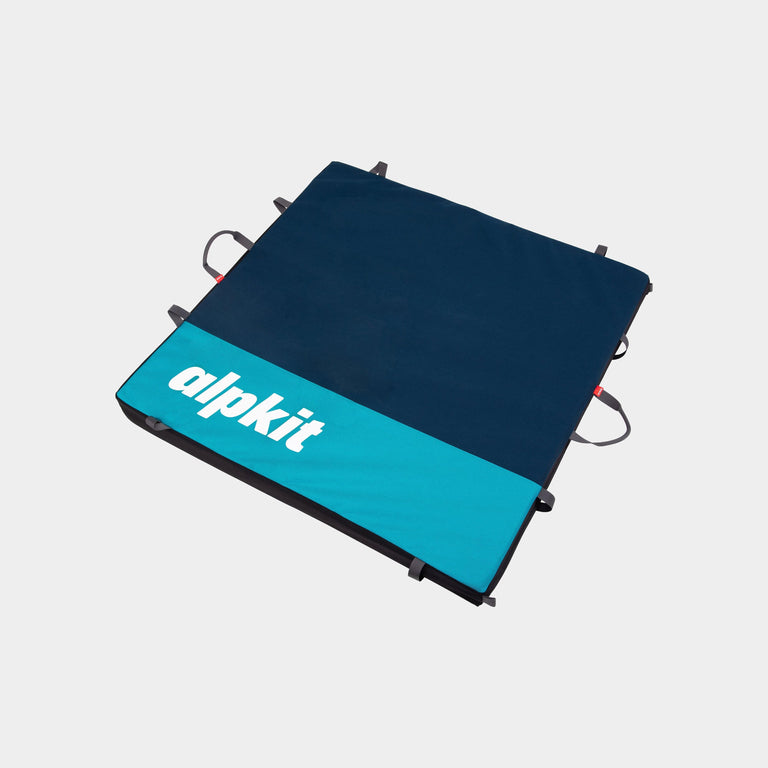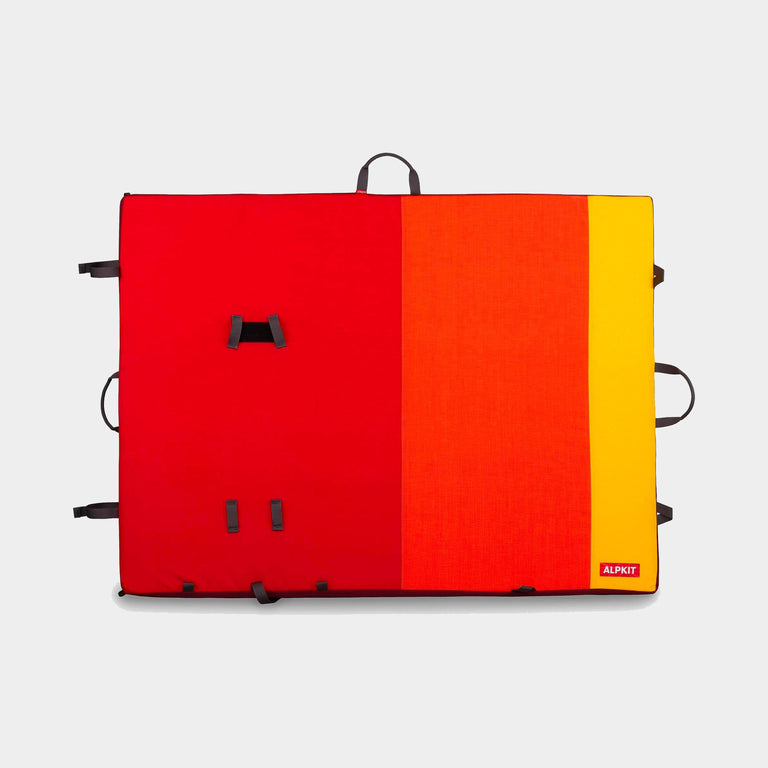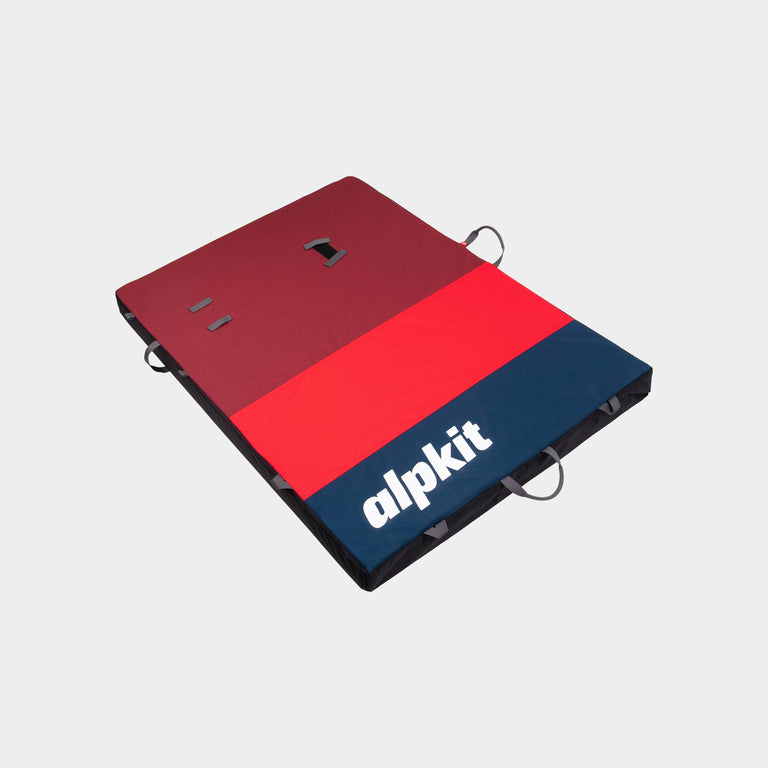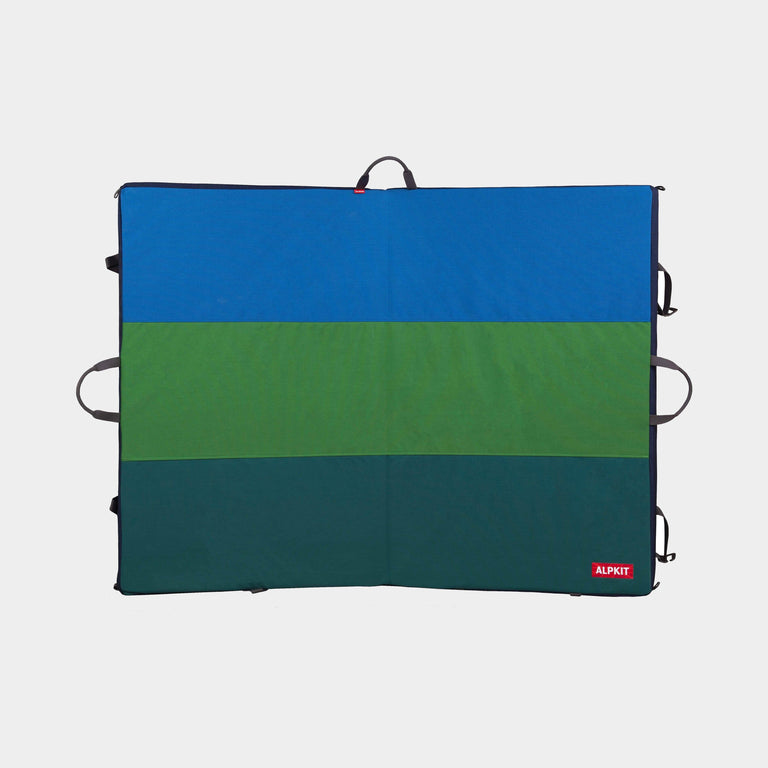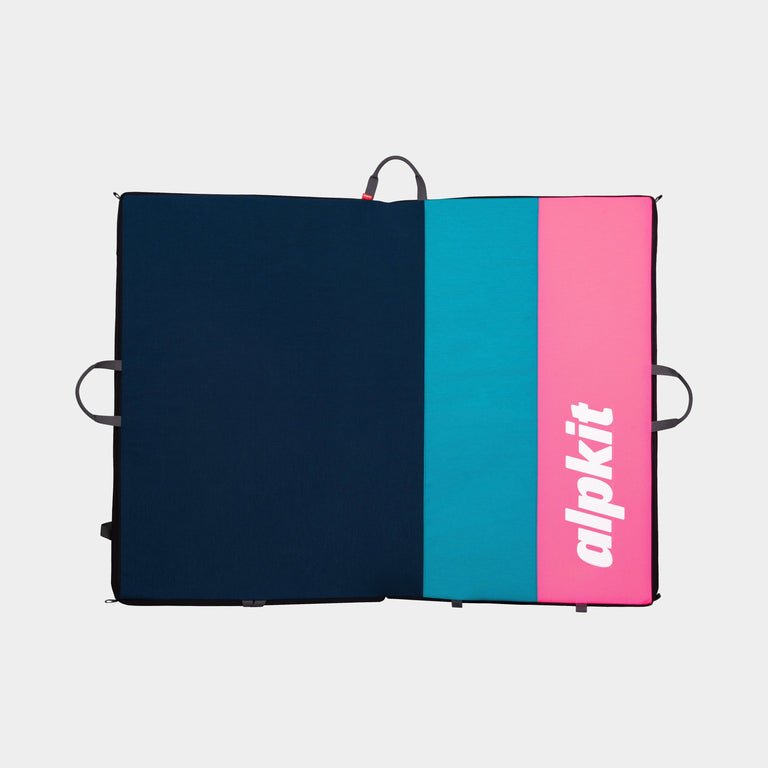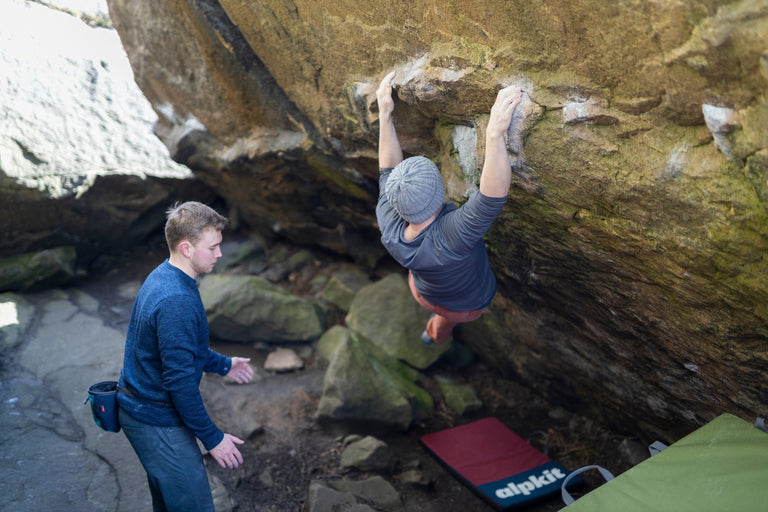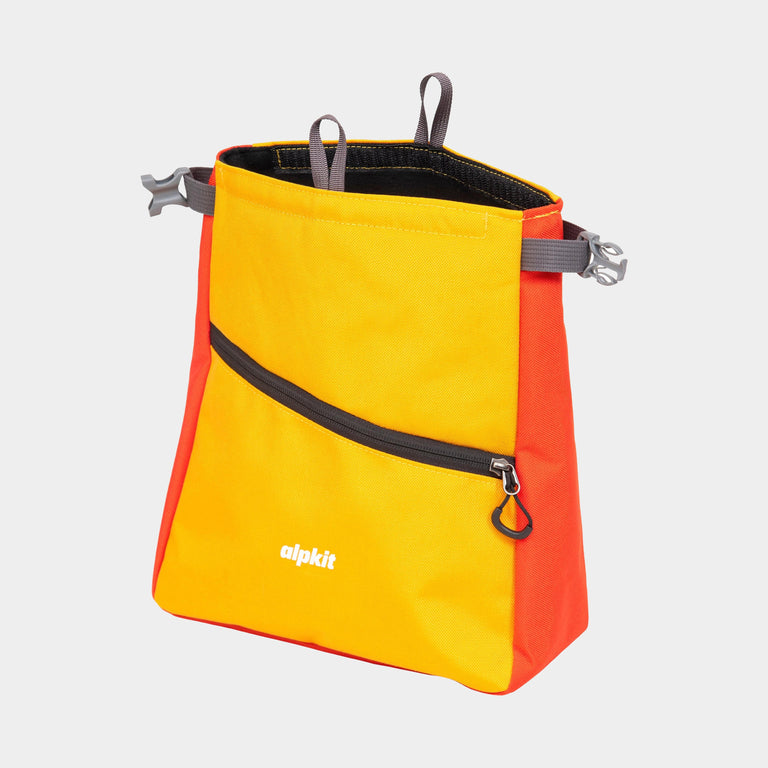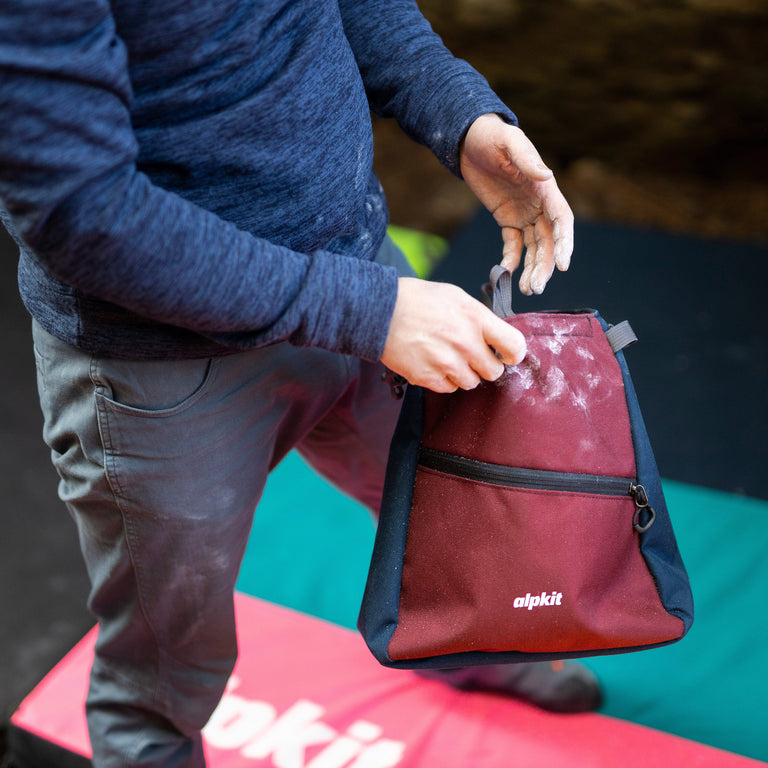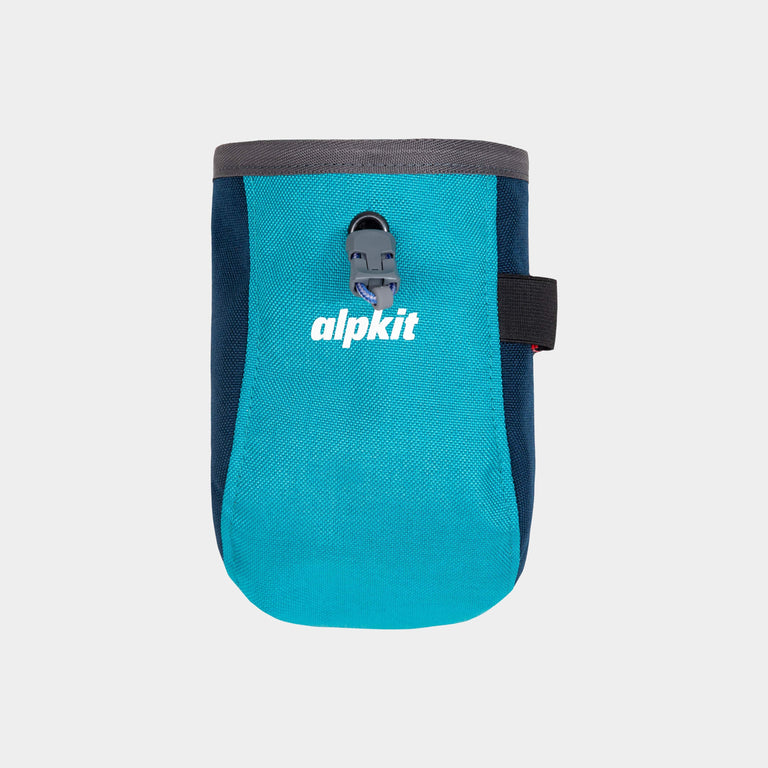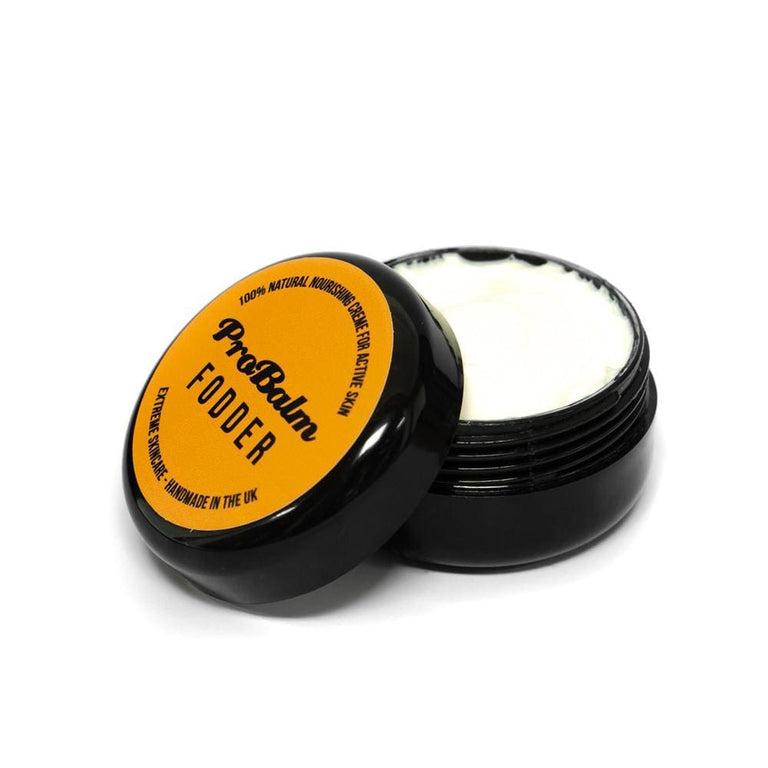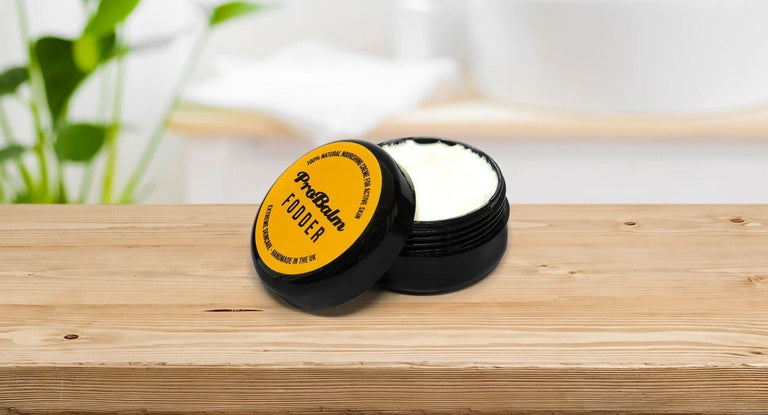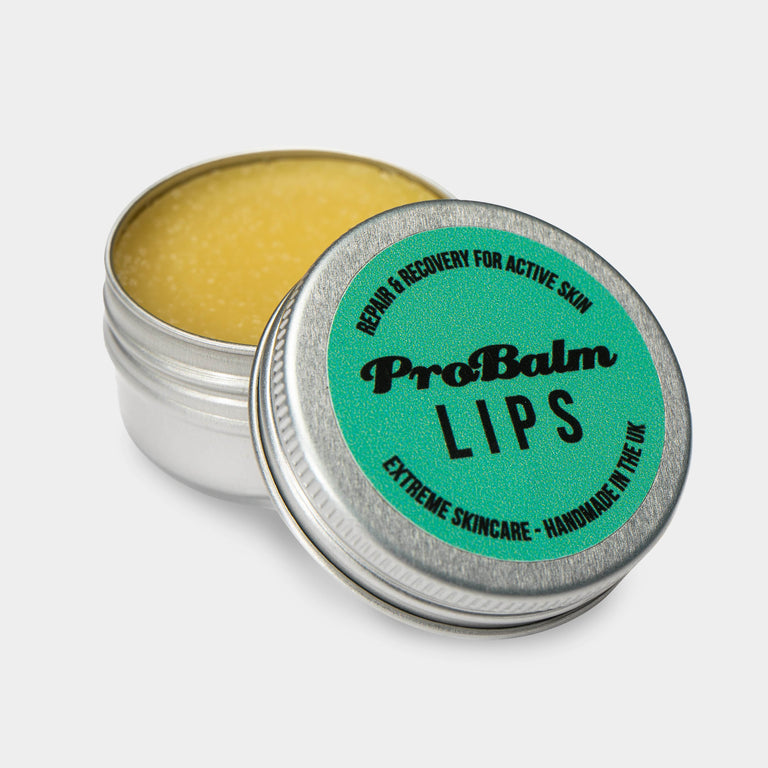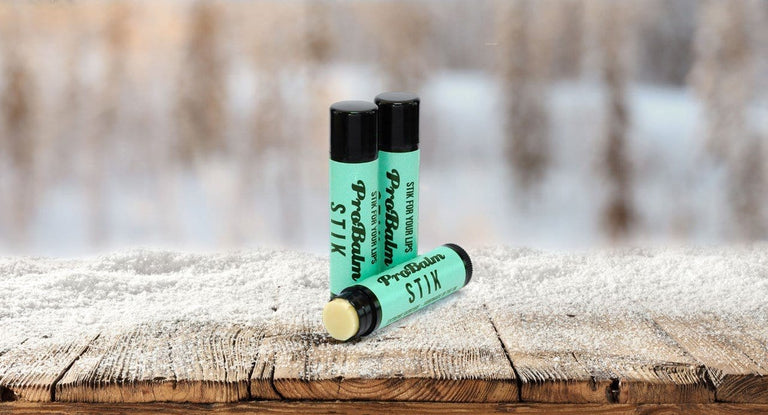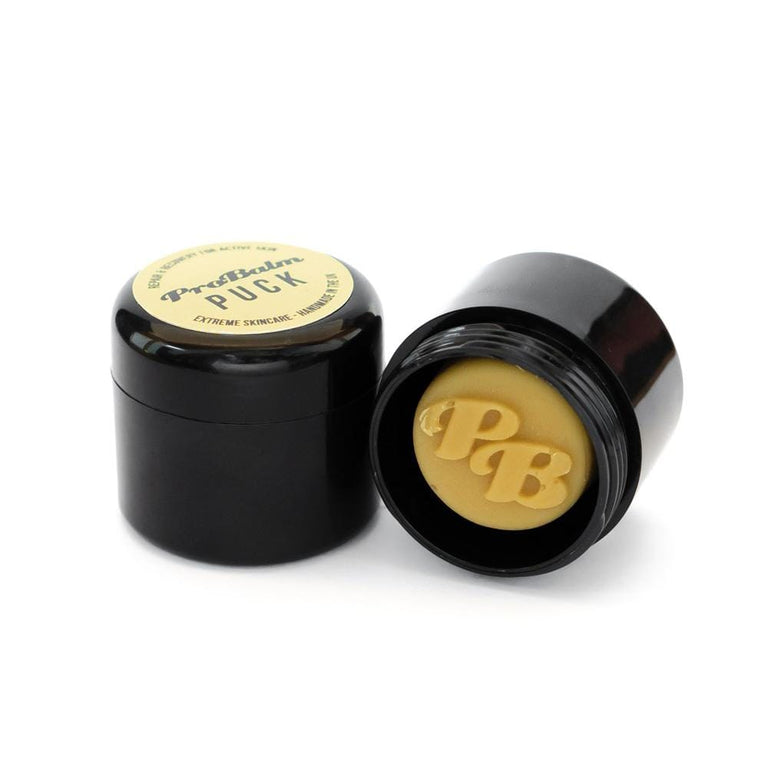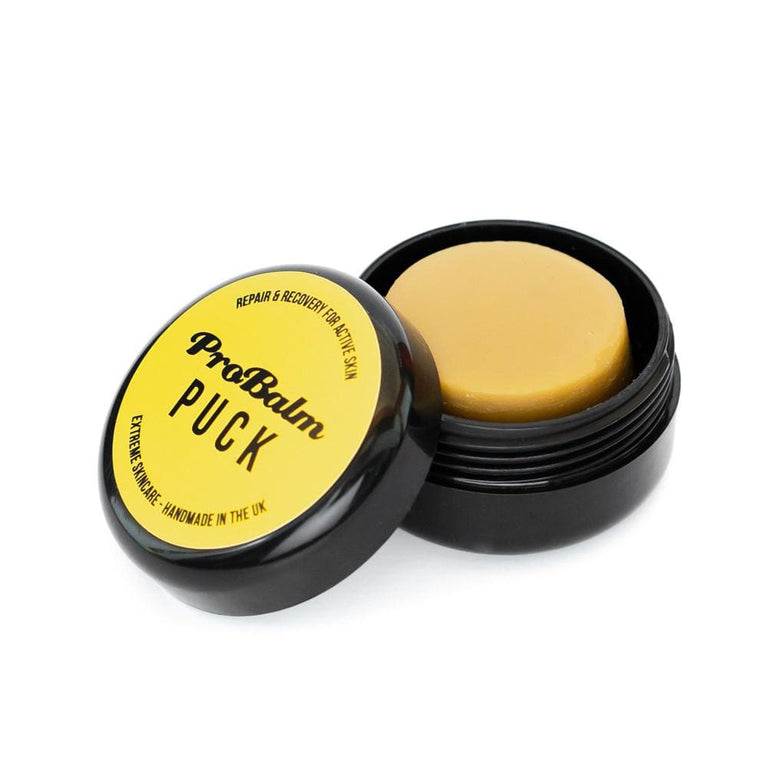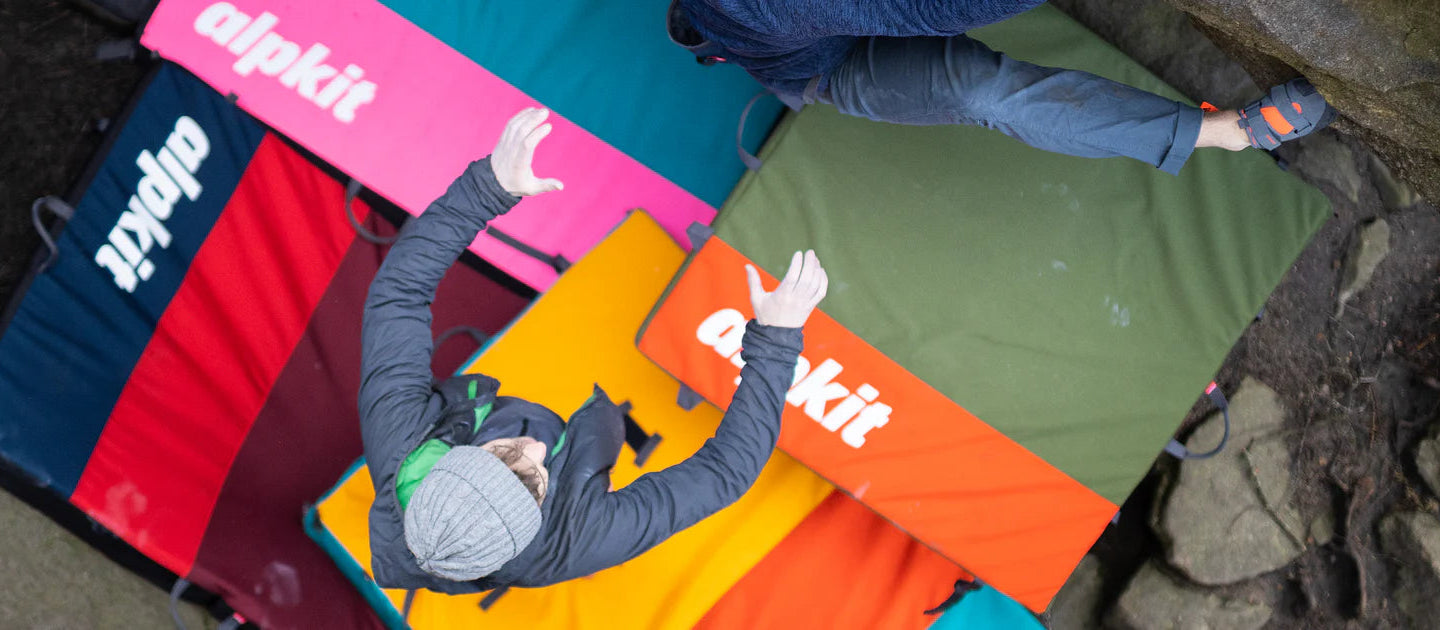
Learn the difference between hinge and taco-style crash pads and discover the best foam for your UK-made bouldering mat to maximize performance and safety.
We've been making bouldering mats for over 15 years, and falling on them long before that.
With every fall is a lesson learnt, and we’ve fallen a lot! Here’s all the advice we can give you on making your crash pad choice.
What is essential to a bouldering pad?
There’s more than just size to consider! A bouldering pad is fundamentally designed to stop it from hurting when you fall off a boulder. So there are three absolute essentials:
-
The foam is going to protect you from the fall.
-
The outer fabric is going to protect the foam from everything else (bogs, rocks, beingstuffed in the boot, etc.).
-
You can comfortably carry it (and all your other stuff) to the bottom of the boulder problem in the first place.
These were our essentials, we’d get this part nailed and all the bells and whistles could come after.
1. The foam is going to protect you from the fall
The first thing you’ll notice in our new range is that the foam is thicker than previous incarnations of our products. The purpose of this is twofold: firstly, thicker foam works better with the refreshed shapes of the pads; secondly boulderers are increasingly after thicker foam.
Our pads tend to feel firm in comparison to other brands, this firmness doesn’t necessarily mean you’ll get a hard fall. What it does mean, however, is that your fall will be better supported – protecting your heels and ankles - and your pad will last longer.
Mujo and Origin are designed to cover the majority of boulderers’ needs, so it was important to find a good balance between protection on higher falls and comfort on smaller falls. We chose to use two layers of foam: open cell to absorb impact and cushion the smaller falls and closed cell to prevent you from bottoming out on higher falls.
The Project is made to handle repeated big falls, so we added another layer of closed cell foam to give you the extra support from the high falls and more protection against rocks or uneven ground beneath the pad.
If you want to really geek out with us on foam, read our High Perfoamance develop post.
2. The outer fabric will protect the foam
One of the major changes in our pad range is the corners, which are now squared off (yes, really, it’s a big deal to us!). Pads with squared off corners fit together better, with less gaps in between, giving you a safer setup. They’re also far easier to stack.
The trade-off for square corners, however, is durability. Our bouldering pads are made here at in the factory at AKHQ. This gives us plenty of scope for both trying and testing fabrics, and looking at how we can construct our pads to be as hardwearing as possible. We’ve opted for 1100 denier Cordura, which we are experienced in working with. Over the years, this fabric has proven it can stand the test of time and a good dose of use and abuse, and more than compensates for the squared-off corners when it comes to durability.
3. You can comfortably carry it
There’s no point in having a great pad if you can’t carry it to the crag. With the exception of the streamlined Phud, our full pads feature rucksack straps and hip belts to make them more comfortable to carry.
Due to its size and weight, portability was a big point of discussion for the Project pad. We used a thermoformed rucksack back panel – such as you might find on our UK made packs – to make it comfortable to carry on the long walk-ins to your project.
What To Consider When Choosing a Bouldering Mat
- How thick does my bouldering mat need to be?
- What types of bouldering mats are there?
- What’s the best bouldering mat carry system?
- What are the best bouldering mat features?

How Thick Does My Bouldering Mat Need to Be?
We find the most versatile crash pads to be between 10-12cm in thickness. These mats tend to cover most of our bouldering needs, and are manageable enough that they can easily be transported around.
Not all pads are created equal though, 12cm of cheap open-cell foam won't do well at protecting you from bottoming out on higher falls. Plus, the outer shell needs to be tough enough to take a beating.

Foam Quality
Foam is what keeps you safe, but not all foam is the same. Don't scrimp on safety, look for durable cross-linked foam - it spreads the force of your impact more effectively and lasts longer.
You'll also often find a combination of closed-cell and open-cell foam. The closed-cell foam is there to add secure protection against the rocks and spread the impact of your fall, the open-cell then acts as a cushion for a softer landing.
Generally speaking, the heavier the pad, the more durable it is and the longer it will sustain bigger falls. Good quality mats are firm because of the dense structure of the foam itself. Lighter, cheaper mats are firm because they use chemical hardeners which break down quicker, leaving you with a lightweight soft and floppy pad within a few sessions.

Outer Shell Construction
Bouldering pads have a tough life. They get dragged through the mud, stacked up against abrasive rocks and take a pounding every time you fall. They need to be made of hardwearing materials like the 1100D Cordura we use, and stitched together with reinforced or bartacked seams that are not going to blow apart when you land.
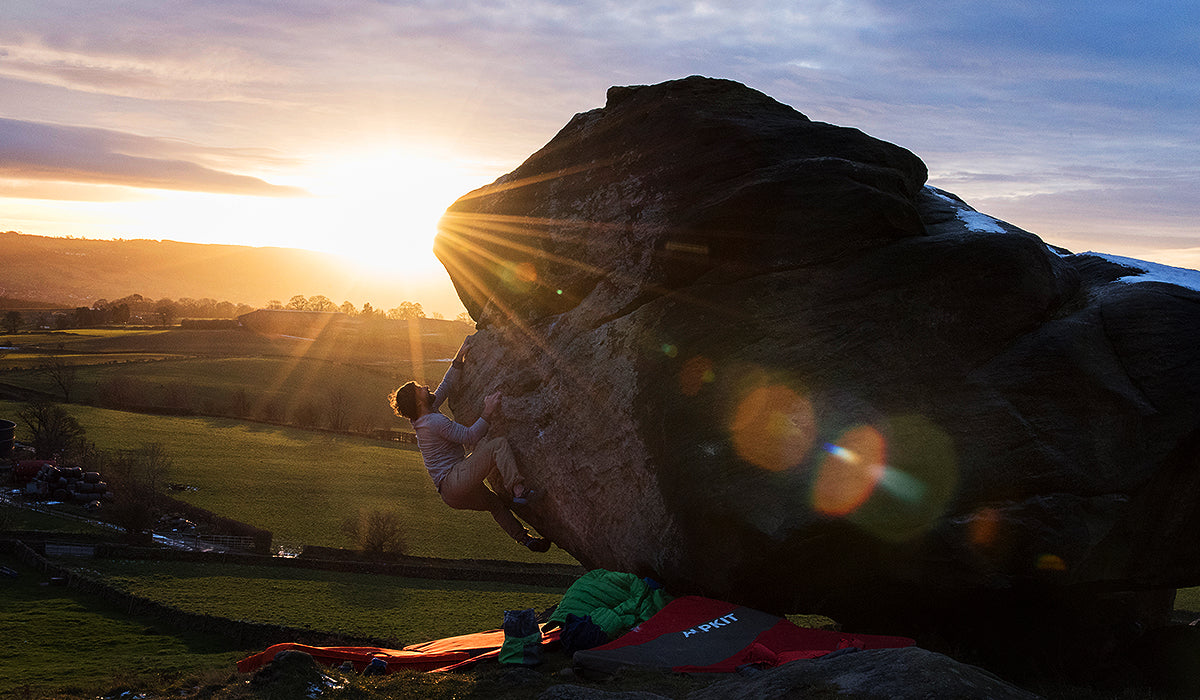
What Types of Bouldering Mats are There?
There are three types of crash pads: satellite, full and oversized. Each plays a specific role in protecting you when you fall. There are also two different types of openings: taco and hinge style pads – these each have their pros and cons too.
Satellite Pads (also known as sit start and slider pads)
These are small crash pads that are used to cover the gaps where two pads meet, protect your fall on a sit-start, protect low traverses or cover outlying roots and rocks. They're usually slim and portable and are used alongside a bigger bouldering mat.
Check out the Waffa if you're after this kind of bouldering mat.

Full pads (also known as main and mid-sized pads)
The crash pad most people buy. There's some size variation in this category, but one full pad should be enough to keep you protected from a mid-level fall. They fold in half so that they can be easily carried and fit into most car boots. High mileage boulderers often have two of these.
Check out the Phud if you boulder infrequently or the Mujo or Origin if you are out most weekends.
Oversized Pads (also known as fat pads)
These crash pads tend to be for protecting you on highball problems, the biggest, baddest climbs around. They're really big mats and excellent at supporting and cushioning your fall. Weighing in around 9/10 kg they require a good carrying system and will fill your car boot (or your entire car if it's a Kia Picanto).

"I love having a big and thick pad, first of all, because I’m easily scared by heights or bad landings, and secondly because it’s perfect for solo outings when I don’t have a spotter. Most big pads are really heavy, or not so comfortable to carry, so I thought that finding one that would tick all the three boxes: huge, light, comfortable; would be impossible. For me, that’s the Project." - Zofia Reych
Hinged Fold vs Taco Fold Bouldering Pads
Bouldering mats fold to make them easier to transport to the crag. There are two types of fold available to climbers: taco and hinge.
Hinged Bouldering Mats
The foam in these pads is cut in half so that they fold flat when closed, a bit like a book. These pads take up less space in your car, are easier to carry and can be stored folded so you're not bending the foam. When you're climbing, hinged pads lie flat on the ground or can be flipped and folded around large rocks in your landing area.

Pros
- Lies flat on the ground
- Easily folded around large rocks
- Comfortable to carry
- Compact to store and transport
- Foam less stressed than in Taco
Cons
- Seam in the middle of the pad
- Can close around you if you land directly on the hinge
- Carrying straps can get dirty
Mujo
11cm Hinge style full bouldering mat for regular rock wranglers
Project
15cm Hinge style oversized bouldering pad for high-ball problems
Taco Bouldering Mats
These pads contain continuous sheets of foam with no seams or hinges in the middle, giving you an uninterrupted landing zone. The pad folds in half like a taco when you're transporting it, leaving a space inside where you can stash stuff to carry it to the crag. Taco pads take up more storage space than a hinged pad for the same landing area and should be stored flat to keep the foam in good condition.

- Uninterrupted landing zone
- Extra carrying capacity
- Carrying straps stay clean
Cons
- Cumbersome to store and transport
- Store open to protect foam
Phud
8cm Light and portable taco style bouldering pad, ideal for whipping round your local circuit
Origin
11cm Taco style main bouldering mat for a portable uninterupted landing zone.
What’s the Best Bouldering Mat Carry System?
Rucksack straps, shoulder straps and carry handles are the most common systems used for carrying your bouldering mats. However the art in getting it right lies with matching a carry system to the pad.
Using the wrong kind of straps on your bouldering mat can lead to some truly frustrating approaches.
Here's how we match up our crash mats to their carry system counterparts.
Rucksack Straps
The heavier the pad, the more support you'll want from your back system. Our favourite carry system for bulky crash pads have rucksack straps and a hip belt to take the strain off your shoulders. The extra support pays dividends on long walk ins.
Rucksack straps also need to be positioned well on the pad, too low and you'll topple over, too high and it'll hit the back of your knees as you're walking.
Shoulder Straps
Smaller full pads might have a single shoulder strap rather than rucksack straps which is really handy for hopping from boulder to boulder (especially on Font circuits). It also means you can wear your backpack for the walk-in.
Grab Handles
We love grab handles! They are convenient for carrying the pad between boulders without having to buckle the pad up, as well as moving it around to spot your friend.
Carrying Multiple Crash Pads
It can feel like an effort to carry multiple full bouldering pads to the crag. Boulderers will often carry one pad using the rucksack straps and hang their second pad over the first using a shoulder strap. If you want to take a third, you'll have to get creative!
Sit-start and slider pads make the multiple pad walk-in much easier as they slot inside your main pad.
"I like when my pads attach to one another without any extra bits which get lost super easily. For example, it’s super easy to put a Mujo over a Mujo (just lengthen the shoulder straps and hook them over the top of the pad that goes on your back) or even a Mujo over the Project. The carrying system is stable enough to take the weight of two pads without feeling like it’s all going to topple over." - Zofia Reych

What are the Best Bouldering Mat Features?
We find that, although not essential, these extra little features can make life a bit easier if you're out bouldering a lot:
- Pockets - Great for storing your guidebook, a towel or spare brushes
- Back Support Cover - If you can't remove your rucksack straps, can you cover them up? It's easy to get psyched and throw your pad in a bog only to pay the price on the walk home with a dirty back.
- Shoe Wipe - Respect the rock! Some crash pads feature a built-in shoe wipe for when you forget to take your doormat/tea towel to the crag.

Custom Bouldering Mats
You can't always get what you want off the shelf. Having in-house design and manufacturing facilities means that we can offer a bespoke design service, so whether it is simply a choice of your favourite colour, extra straps, thicker foam or a completely unique mat, just to get in touch!
Ready to Boulder?
We are boulderers and climbers, we hand-make our own pads so we understand what makes an excellent crash pad.
If you are still unsure which bouldering mat is right for you, why not visit one of our stores and hire a bouldering mat.
"It’s important to ask yourself what kind of days you’re mostly expecting to do: volume days, or projecting days? Easy walk-ins, or long walk-ins over tricky terrain? Then, choose a pad accordingly with the biggest question being its size, especially if you’re buying only one. If you don’t mind having a pack in the front, hinge pads tend to be slightly more durable but if (like myself) you like having your hands free, a taco fold is a perfect solution as you can take everything you carry with you on the walk-in." - Zofia Reych

